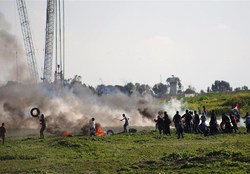 Israeli forces killed three Palestinians and injured more than 300 others as people of Gaza start their mass rallies marking the anniversary of the Great March of Return and the Palestinian Land Day.
Israeli forces killed three Palestinians and injured more than 300 others as people of Gaza start their mass rallies marking the anniversary of the Great March of Return and the Palestinian Land Day. RNA - Tens of thousands of Palestinians rallied in Gaza Strip on Saturday to mark the first anniversary of the Great March of Return protests, facing off against Israeli tanks and troops massed on the fortified perimeter, Middle East News reported.
The Ministry of Health announced that three protesters were killed by Israeli gunfire, and 316 were injured, including 86 children, 29 women, 3 medics, and 6 journalists.
The martyrs were identified as Adham Amara, Tamer Abu al-Kheir, and Belal al-Najjar. The three are aged 17. Amara died after being shot in the face East of Gaza City. Abu al-Kheir was shot in the chest East of Khan Younis in southern Gaza and died at a hospital. Al-Najjar, was killed by an Israeli gunshot, according to Gaza officials.
Also, a Palestinian youth died at dawn Saturday from wounds he sustained after being shot by the Israeli occupation forces in the Great March of Return in Gaza. Spokesman for the Ministry of Health Ashraf al-Qedra announced that martyr Mohammad Saad, 20, was hit by shrapnel in the head during a border demonstration East of Gaza city.
Spokesman for the Gaza Ministry of Interior and National Security Iyad al-Bozom said in a statement that the ministry deployed 8,000 of its security forces along the border to help and protect the demonstrators.
A recent report said Israeli snipers deliberately inflict crippling injuries on Palestinian protesters, especially to their lower limbs, in a bid to create a generation on crutches in the besieged Gaza Strip.
Israeli snipers have intentionally maimed Palestinians demonstrating in Gaza over the past year, creating a generation of disabled youth and overwhelming the territory's already crippled medical system, frontline doctors told the Middle East Eye.
As Palestinians marked a year of weekly demonstrations on Saturday, medical groups operating in the coastal enclave expressed concern over the thousands of people who have been wounded.
Doctors Without Borders (MSF) announced that Gaza had been "completely abandoned" over the past 12 months of rallies and that "the more than 6,500 people shot by Israeli forces during the protests have been largely left to their fate".
According to the medical charity, the vast majority of those injured had suffered leg wounds.
"These are not simple wounds that can be easily stitched up. Huge chunks of legs have been blown out and the bones within shattered," the group noted.
At the moment, Gaza does not have the capacity to treat all of its patients.
"We have a situation where the health system is overwhelmed, although MSF is doing all it can, we also won't be able to treat all those patients," MSF field coordinator Carla Melki said.
Before the anniversary of the Great March of Return protests, MSF stressed that its teams were gearing up for a "state of emergency".
"We're increasing our bed capacity. We are preparing for the worst scenario, as everybody thinks [like this] in Gaza," Melki added.
The United Nations Human Rights Council announced last week that Israeli troops may have committed war crimes by using excessive force against the protests.
Palestinians in the Gaza Strip have demonstrated along the fence demanding their right to return to the homes and land their families were expelled from 70 years ago. The Great March of Return rallies culminated on May 15 to mark what Palestinians refer to as the Nakba, or Catastrophe - a reference to the forced removal of 750,000 Palestinians from their homes and villages to clear the way for Israel's establishment in 1948.
Nearly 280 Palestinian protesters have been killed and more than 31,000 Palestinians injured by Israeli forces since the outbreak of the Great March of Return rallies at Gaza border in late March 2018.
The Gaza clashes reached their peak mid-May last year which coincided with the US embassy relocation from Tel Aviv to the occupied East Jerusalem al-Quds.
The UN children’s agency announced that around 40 children have been killed in one year of demonstrations along the fence that separates the besieged Gaza Strip and the Israeli-occupied territories.
According to UNICEF on Thursday, almost 3,000 others have been hospitalized with injuries since the start of the protests one year ago, many leading to life-long disabilities.
UNICEF's Middle East Director Geert Cappelaere voiced anger at the growing number of casualties, calling for an end to violence against children in Gaza and elsewhere across the occupied territories.
"UNICEF reiterates its outrage at the very high numbers of children who have been killed and injured as a result of armed conflict 2018," Cappelaere said
Last month, Cappelaere also expressed sorrow over the killing of Palestinian teenage boys by Israeli gunfire in the Gaza Strip.
Israeli troops have shot and killed dozens of Palestinian children in the occupied West Bank and the besieged Gaza Strip in recent months.
Gaza has been under Israeli siege since June 2007, which has caused a decline in living standards. Israel has launched three major wars against the enclave since 2008, killing thousands of Gazans each time and shattering the impoverished territory’s already poor infrastructure.
About 80 percent of the Gaza population is dependent on humanitarian assistance, while the strip experiences regular power outages and high unemployment. It has been dubbed as the world's largest open-air prison, with Palestinians needing Israeli army permits to enter and exit the enclave.
847/940